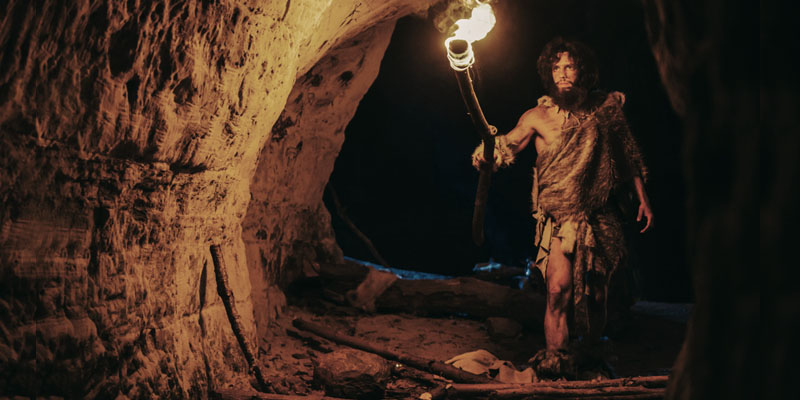Table of Contents
We explore the Paleolithic, and discuss its characteristics and divisions. In addition, we explain the social development achieved during this period.

What is the Paleolithic?
The Paleolithic was the initial stage of the Stone Age, which was succeeded by the Mesolithic and Neolithic stages, the latter marking the end of the period. The term Paleolithic comes from Greek meaning "ancient stone".
The Paleolithic began with the emergence of humans around 2.5 million years ago and spanned until 10,000 BC. It was the longest stage of the Stone Age, and was characterized by the use of rudimentary tools (such as chipped stone), and the control of fire, as well as hunting, fishing, and gathering activities.
Stone tools represent the earliest cultural artifacts that historians use to reconstruct the lives of humans during the Paleolithic. Traces of cave paintings show scenes depicting fruit gathering and hunting carried out in groups.
- See also: Mesolithic
Characteristics of the Paleolithic
The main characteristics of the Paleolithic are:
- It began 2.5 million years ago and ended in 10,000 BC.
- Communities were nomadic and foraged in small groups.
- The primary subsistence activities were fruit gathering and hunting.
- During this period, fire was discovered and controlled.
- Humans sought shelter in rudimentary huts and caves (hence the name "cavemen" given to Paleolithic humans).
- The earliest rudimentary tools were made, initially from chipped stone. Later, other materials such as wood and bone were incorporated.
- Paleolithic humans engaged in fishing, particularly Neanderthals.
- Art emerged as evidence of cultural development.
- A primitive language originated, which enabled the development of more complex social structures.
Paleolithic Stages

The Paleolithic Period is divided into three stages:
- Lower Paleolithic. It began 2.5 million years ago and ended 250,000 years ago. Humans were nomadic, and sought refuge in caves to protect themselves from the cold and from wild animals. The major event during this period was the discovery and control of fire.
- Middle Paleolithic. It began 250,000 years ago and ended in 30,000 BC. Humans, in continuous evolution, evolved into the Neanderthal man, characterized by a sophisticated intelligence and the improvement of weapons used for hunting.
- Upper Paleolithic. It spans from 30,000 BC to 10,000 BC. This period witnessed the greatest artistic development of the time, evidenced in cave paintings and small sculptures made of clay or bone. Humans evolved into the Cro-Magnon man, with a greater ability to communicate.
Social development of the Paleolithic

During the later part of the Paleolithic Period, humans developed the ability to communicate, which allowed them to become organized into larger populations. This gave rise to the division of roles and tasks within the family clan.
Men went hunting and protected women and children. In turn, women gathered fruits, took care of children, and worked animal skins for clothing and the construction of shelters.
Economy of the Paleolithic
The economy of the early stages of the Paleolithic was dominated by the gathering of vegetables and fruits. The Australopithecus and Homo habilis were largely herbivorous or omnivorous beings, depending on plants for subsistence. At the beginning of the Paleolithic, hunting was a poorly developed activity.
As the early hominids evolved and their tools improved, hunting became more important for the economy of Paleolithic societies. With the emergence of Homo erectus, hunting became a central activity, as this species possessed the necessary anatomy and tools for hunting larger animals and processing their meat efficiently.
Throughout the entire period, the economy was predatory. This means that once the resources of a given territory were exhausted, human groups foraged to other areas in search of new sources of food.
Technology of the Paleolithic
Early in the Paleolithic, tools were rudimentary and predominantly made of stone. With the emergence of Homo habilis, more elaborate stone tools appeared, including hand axes and hammers. These improved designs enabled humans to perform a variety of tasks such as cutting meat and working wood and bone.
Tools were used not only for everyday tasks, but also as weapons for hunting and defense. New technologies facilitated the procurement of natural resources and the manufacture of essential objects.
Over the course of time, the evolution of hominids made further improvements in tool making possible, such as arrowheads and spears, which were used for hunting larger animals.
Beliefs of the Paleolithic
From the study of the Paleolithic Period, various theories have emerged regarding the religious and spiritual behavior of early humans. It is believed that Paleolithic people may have engaged in sophisticated practices concerning the dead and funeral ceremonies.
This idea stems from evidence suggesting that the dead would have been buried to protect them from scavenging animals. Furthermore, human remains have been found alongside what might have been offerings (remains of animals and art statuettes they themselves crafted).
These findings indicate that early human civilizations would have honored and cared for the dead, with some theories even suggesting the belief in the afterlife.
Explore next:
Was this information useful to you?
Yes NoThank you for visiting us :)